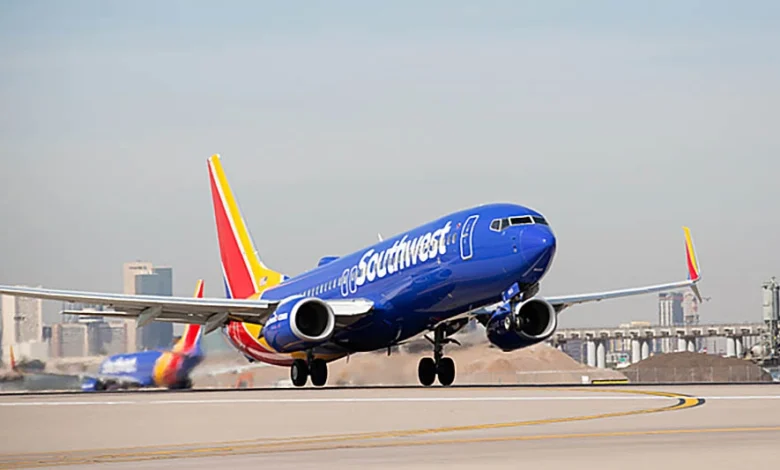Exploring the Southwest Airlines Boeing 737 Max: The Future of Air Travel

Introduction to Southwest Airlines Boeing 737 Max
Southwest Airlines Boeing 737 Max has taken a significant step forward in its operations with the introduction of the Boeing 737 Max into its fleet. The Boeing 737 Max is a modern, fuel-efficient aircraft that offers enhanced performance and passenger comfort. This new aircraft represents a crucial addition to the airline’s operational capabilities, particularly as it navigates an increasingly competitive market focused on efficiency and sustainability.
The Boeing 737 Max was designed with advanced technology that includes more fuel-efficient engines, winglets for improved aerodynamics, and a revamped cabin layout. It provides additional legroom and modern amenities, thereby fostering an improved travel experience for passengers. By integrating this aircraft into its offerings, Southwest Airlines enhances its reliability, driving down operating costs and allowing the airline to focus on providing exceptional service.
For Southwest Airlines, the rationale behind introducing the Boeing 737 Max is multifaceted. Primarily, it allows the airline to decrease its overall environmental footprint, as the aircraft is designed to consume less fuel compared to its predecessors. With sustainability becoming a focal point for airlines worldwide, the inclusion of the Boeing 737 Max aligns with Southwest’s commitment to reduce emissions and enhance operational efficiency.
As the airline continues to adapt to changing consumer preferences and environmental considerations, the introduction of the Boeing 737 Max cements Southwest’s position as a forward-thinking carrier that prioritizes innovation and customer satisfaction. With an expected increase in passenger volume, this aircraft is poised to play a pivotal role in the airline’s future growth strategies. In the evolving landscape of air travel, the Boeing 737 Max stands out as a significant milestone for Southwest Airlines.
The Features of the Boeing 737 Max
The Boeing 737 Max represents a significant advancement in the aviation industry, primarily due to its innovative features that enhance performance and passenger experience. One of the standout characteristics of the 737 Max is its remarkable fuel efficiency. This aircraft incorporates advanced LEAP-1B engines, which not only reduce aerodynamic drag but also contribute to a decrease in fuel consumption by approximately 15% compared to its predecessors. The reduction in fuel use leads to lower operating costs, making the Boeing 737 Max an attractive option for airlines looking to improve their economic performance.
In addition to its fuel efficiency, the Boeing 737 Max is designed with cutting-edge aerodynamics that enable it to glide smoothly through the air. Features such as larger winglets significantly enhance lift and reduce drag, further optimizing its performance. These winglets allow the aircraft to operate more efficiently at higher altitudes, which can lead to shorter flight times and a reduced carbon footprint. As a result, the Boeing 737 Max is not only beneficial for airlines but also aligns with global efforts toward more sustainable aviation practices.
Passenger comfort is also a priority in this aircraft’s design. The cabin of the Boeing 737 Max is spacious, featuring wider seats and redesigned overhead bins that accommodate more luggage. Enhanced lighting and larger windows improve the overall travel experience, allowing natural light to filter through. The aircraft is equipped with the latest in-flight entertainment systems, offering passengers a selection of films, music, and other content during their journey. By focusing on both technological advancements and passenger satisfaction, the Boeing 737 Max sets a new benchmark in air travel.
Safety Improvements in the Boeing 737 Max
The Boeing 737 Max has undergone significant safety enhancements following the challenges experienced with earlier models. Southwest Airlines has been at the forefront of implementing these improvements to ensure the utmost safety for its passengers and crew members. After the temporary grounding of the Boeing 737 Max, comprehensive redesigns and system overhauls were undertaken, addressing the technical issues that had arisen.
One key improvement is the updated Maneuvering Characteristics Augmentation System (MCAS), which has been modified to enhance the aircraft’s response to pilot inputs. This system is essential for maintaining stability and ensuring that the aircraft remains under pilot control during various flight scenarios. To further bolster safety, additional safeguards have been integrated into the system, including multiple sensor inputs to prevent erroneous activations. These modifications aim to prevent the circumstances that previously led to accidents and improve the overall handling of the aircraft.
Furthermore, Southwest Airlines has invested significantly in comprehensive pilot training programs aimed at familiarizing its flight crews with the Boeing 737 Max’s new systems. This training emphasizes three critical areas: understanding the updated MCAS and its functionalities, recognizing potential failure modes, and managing in-flight scenarios where decisions must be made swiftly. By enhancing pilot preparedness, the airline ensures that its crew can handle unexpected challenges effectively.
Maintenance protocols have also been reinforced to include rigorous inspections and checks specific to the Boeing 737 Max. These practices ensure that every aircraft in the fleet meets the highest safety standards and operates optimally. Through these combined efforts, Southwest Airlines is dedicated to rebuilding confidence among travelers and committing to the safety of all air travel on its Boeing 737 Max fleet.
Environmental Impact and Fuel Efficiency
The aviation industry has made significant strides towards sustainability, with a particular emphasis on reducing environmental impacts. The Southwest Airlines Boeing 737 Max is at the forefront of this shift, designed with innovative technologies that enhance fuel efficiency and minimize carbon emissions. This aircraft features advanced engines that are approximately 14% more fuel efficient than those used in previous models, greatly contributing to lowering overall carbon footprints.
In addition to its fuel-efficient engines, the Boeing 737 Max incorporates lightweight materials and aerodynamic improvements, both of which further enhance its performance and efficiency. These design advancements allow for lower operational costs while simultaneously reducing the number of greenhouse gases emitted during flight operations. As airlines globally transition to more efficient fleets, the Southwest Airlines Boeing 737 Max sets a strong example of how modern aircraft can align function with sustainability.
Southwest Airlines is not only investing in the electronic advancements of the Boeing 737 Max but also ensuring that its overall operations conform to increasing environmental regulations and community expectations. The airline’s commitment to sustainable aviation is reflected in its broader initiatives, which include optimizing flight routes, minimizing ground time, and utilizing Ground Power Units (GPUs) to reduce reliance on auxiliary power units during idling on the tarmac.
Furthermore, Southwest’s focus on integrating renewable aviation fuels lays the groundwork for even greater emission reductions. By employing the latest in aviation technology and sustainable practices, Southwest Airlines aims to enhance its contribution to the airline industry’s shift towards greener operations. As such, the Southwest Airlines Boeing 737 Max symbolizes not just a technological advancement but a robust step towards ensuring that the future of air travel is both efficient and environmentally responsible.
Passenger Experience on the Southwest Airlines Boeing 737 Max
The passenger experience aboard the Southwest Airlines Boeing 737 Max is designed with comfort and convenience in mind, catering to modern travelers’ expectations. This aircraft features a unique cabin layout that stands out in the market. The 737 Max typically accommodates up to 175 passengers in a single-class seating configuration, allowing for efficient use of space while maximizing the number of seats available. The seating arrangement is configured in a 3-3 pattern, ensuring that families and individual travelers alike have easy access to their seats, as well as ample space in the aisles.
In terms of comfort, the Southwest Airlines Boeing 737 Max boasts wider seats and improved legroom compared to previous models, which enhances the travel experience significantly. Many passengers have praised the cushioning and ergonomic design, indicating that even on longer flights, one can enjoy relative comfort. Notably, the aircraft is also equipped with larger overhead bins, providing travelers the ability to store their carry-on luggage conveniently, thus reducing clutter in the cabin.
Furthermore, in-flight entertainment options have evolved with the introduction of the 737 Max. Passengers can access a variety of entertainment through personal devices via Southwest’s onboard Wi-Fi. This service includes the ability to stream movies, TV shows, and even live television directly to smartphones and tablets. While the airline does not provide seatback screens, many travelers appreciate the flexibility offered by the wireless entertainment system.
Testimonials from passengers reflect an overall satisfaction with their experiences aboard the Southwest Airlines Boeing 737 Max. Travelers frequently comment on the friendly service staff, clean cabins, and the aircraft’s smooth flying capabilities. Such feedback underscores the airline’s commitment to providing an enjoyable flight experience, ultimately contributing to a favorable view of the future of air travel with the Boeing 737 Max.
Operational Efficiency and Route Expansions
The introduction of the Southwest Airlines Boeing 737 Max has significantly enhanced the operational efficiency of the airline, allowing it to optimize its routes and increase its service capacity. The Boeing 737 Max offers advanced aerodynamic properties and improved fuel efficiency compared to earlier models. With an upgraded engine and a lighter structure, the aircraft provides a 14% increase in fuel efficiency, which is crucial in reducing operating costs. This reduction aligns with Southwest’s commitment to maintaining low fares while providing quality service.
As a result of these efficiency gains, Southwest Airlines has been able to not only maintain its existing routes but also expand into new markets. The Boeing 737 Max’s performance capabilities enable it to serve both short-haul and medium-haul routes effectively. This flexibility ensures that Southwest can strategically enter new cities and enhance connectivity, thereby attracting a broader passenger base. The introduction of this modern aircraft facilitates improved frequency on popular routes, catering to both business and leisure travelers.
Furthermore, the Southwest Airlines Boeing 737 Max contributes to the airline’s overall expansion strategy by increasing its seating capacity without compromising passenger comfort. With a higher number of seats available, the airline can maximize revenues on high-demand routes, which is particularly crucial as travel demand rebounds post-pandemic. These operational improvements and route expansions underscore Southwest’s competitive edge in the industry, as it continues to harness technology to meet evolving consumer needs. Overall, the deployment of the Boeing 737 Max serves as a vital component in the airline’s efforts to enhance operational efficiencies while adapting to market opportunities.
Challenges Faced by Southwest Airlines with the Boeing 737 Max
The introduction of the Boeing 737 Max to Southwest Airlines’ fleet has been marked by significant challenges. One of the most pressing issues was the extended delays in the aircraft’s rollout. Initially slated for service in 2017, the Boeing 737 Max was grounded for an extended period following two tragic accidents involving the aircraft type. This situation forced Southwest Airlines to adjust its operational strategies, as the anticipated addition of the Max aircraft was essential for meeting increasing passenger demand and optimizing route efficiency.
In addition to operational delays, Southwest Airlines faced considerable hurdles related to public perception. The grounding of the Boeing 737 Max in 2019 led to a decline in consumer confidence in this aircraft model. Despite the safety upgrades and the rigorous assessments conducted before the return of the Max to service, the lingering apprehension among travelers posed a unique challenge for Southwest Airlines. The airline invested in extensive communication strategies to rebuild trust, emphasizing its commitment to passenger safety and the rigorous safety protocols implemented on the Boeing 737 Max.
Moreover, Southwest has been proactive in managing these hurdles by leveraging its strong customer service reputation. The airline offered flexibility in scheduling and reassured travelers through transparent information sharing regarding the Boeing 737 Max’s safety improvements. By focusing on customer engagement and maintaining high standards of service reliability, Southwest Airlines endeavored to mitigate potential damage to its brand image while gradually reintroducing the Max into its operations.
In navigating the complexities associated with the Boeing 737 Max, Southwest Airlines has demonstrated resilience and adaptability. These challenges, albeit significant, have forged a path toward reinstating the aircraft as a safe and reliable option for air travel.
Future Prospects for Southwest Airlines Boeing 737 Max
The future of the Southwest Airlines Boeing 737 Max appears promising, particularly as the airline continues to integrate this advanced aircraft into its operational framework. The 737 Max is designed for efficiency and performance, making it conducive to the evolving needs of both the airline and its passengers. With improved fuel efficiency and reduced emissions, it aligns with the industry’s increasing focus on environmental sustainability. This attribute not only enhances operational cost savings but also positions Southwest Airlines as a leader in eco-conscious travel.
Looking forward, there is potential for Southwest to expand its fleet of Boeing 737 Max aircraft. Recent reports indicate that the airline is eyeing additional orders, reflecting confidence in the aircraft’s ability to meet demand. The combination of increased capacity and operational efficiency could result in enhanced connectivity, allowing for more routes and frequency of flights. As travel demand rebounds post-pandemic, Southwest Airlines is strategically positioned to leverage the 737 Max to maximize its market presence.
Moreover, customer experience is a vital area where the airline plans to innovate further. The implementation of the 737 Max provides an opportunity to introduce enhanced onboard amenities and digital connectivity options. As the airline emphasizes passenger comfort and convenience, travelers can expect a more enjoyable flying experience. The integration of modern technology within the cabin, coupled with improved seating configurations, is expected to attract new clientele while bolstering loyalty among existing customers.
In conclusion, as Southwest Airlines fully embraces the advantages presented by the Boeing 737 Max, the airline is likely to reshape its operations in significant ways. Through potential fleet expansion and a commitment to enhancing the overall customer experience, the 737 Max is set to play a pivotal role in the airline’s future strategy, reinforcing its commitment to efficiency, sustainability, and passenger satisfaction.
Conclusion: The Role of Boeing 737 Max in Air Travel’s Next Chapter
In reflecting on the advancements and innovations brought by the Southwest Airlines Boeing 737 Max, it becomes clear that this aircraft is at the forefront of a transformative period in air travel. The introduction of the Boeing 737 Max signifies a commitment by airlines, including Southwest, to enhance operational efficiency, fuel economy, and passenger comfort. With the aviation industry recovering from previous challenges, the capabilities of the Boeing 737 Max provide a robust foundation for growth and sustainability.
The operational benefits of the Boeing 737 Max are significant. It offers airlines greater fuel efficiency and reduced carbon emissions compared to older models. This is particularly relevant in today’s environment, where airline operators are increasingly focused on meeting both regulatory standards and passenger expectations for more sustainable travel options. For Southwest Airlines, the introduction of the Boeing 737 Max aligns with its vision for a customer-centric experience that prioritizes comfort and reliability without sacrificing affordability.
Moreover, the aircraft’s advanced technological features, including improved cabin design, quieter engines, and enhanced safety measures, make it a formidable player in the competitive landscape of commercial aviation. As Southwest Airlines sets its sights on expansion and service improvements, the integration of the Boeing 737 Max into its fleet reinforces its commitment to innovation and quality service. The future of air travel is undoubtedly interwoven with the capabilities of this aircraft, which propels airlines towards a more efficient and customer-focused paradigm.
Ultimately, as we look ahead, the significance of the Southwest Airlines Boeing 737 Max extends beyond mere fleet expansion; it embodies an airline’s strategic response to an evolving market, shaped by the need for increased efficiency and enhanced passenger experiences. The journey forward promises to be one marked by continuous innovation and proactive adaptation to the ever-changing demands of the aviation industry.
You May Also Read This Usaworldtoday.




